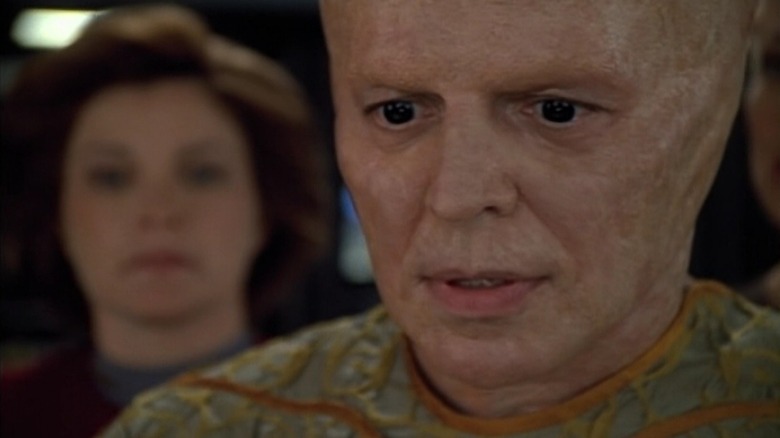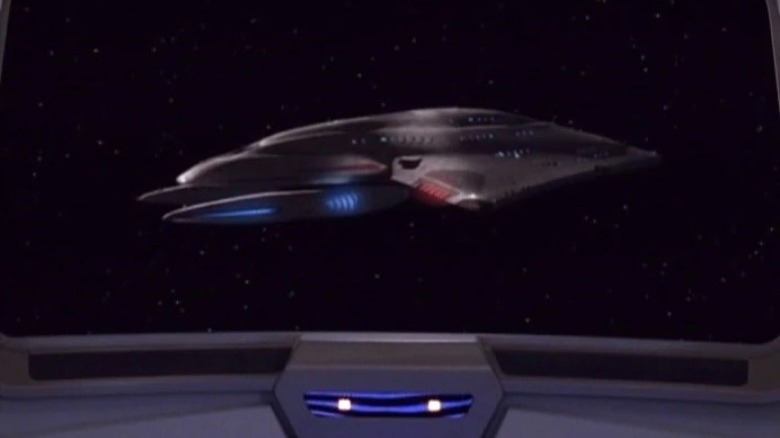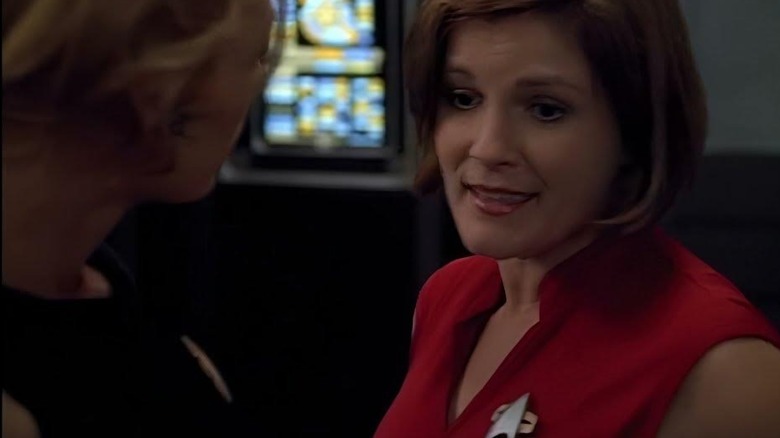Star Trek: Voyager's VFX Team Fought Hard Against One Hope And Fear Scene
In the "Star Trek: Voyager" episode "Hope and Fear" (May 20, 1998), a visiting alien named Arturis (Ray Wise) helpfully translates some coded information that the U.S.S. Voyager had recently discovered on an abandoned communications network. Arturis unexpectedly decodes the location of a nearby empty Starfleet vessel called the U.S.S. Dauntless, an experimental craft that is equipped with a new kind of warp "slipstream" technology. The Dauntless, unbeknownst to the Voyager crew, was sent specifically out to the Delta Quadrant to bring the Voyager crew back to Earth, and Captain Janeway (Kate Mulgrew) is elated.
It will eventually be revealed, of course, that the Dauntless is an elaborate booby trap constructed by Arturis, who had been secretly hellbent on revenge. His species had recently been assimilated by the Borg, and he blamed Janeway for his planet's destruction. About a year earlier, Janeway had allied with the Borg to pass through a portion of their space safely. Rather than destroy the Borg, she let them go on with their destructive plan, and Arturis' world was destroyed shortly thereafter. Arturis planned to use the fake Dauntless to shunt Janeway and her crew directly back into Borg space where they would be assimilated themselves.
The slipstream technology was real, however, and there are several scenes wherein the Voyager and the Dauntless are soaring through what looks like a cosmic tunnel, traveling at unfathomable speeds. The special effects used to create the slipstream were discussed at length in the November 1998 issue of Cinefantastique magazine, and the crew were proud of what they had created. An issue arose, however, when they realized they needed to show the Voyager making a U-turn at high speeds. Some conflict arose over how that would be visually accomplished.
TV CGI in 1998
It's worth noting that "Star Trek" was shifting over to CGI technology in the late 1990s, a dramatic change from the physical models the franchise typically employed throughout "Star Trek: The Next Generation" and most of "Star Trek: Deep Space Nine." CGI looked different but allowed the writers to go a little wilder with their spaceship concepts. The exterior of the Dauntless was designed by longtime Trek designer Rick Sternbach, and it was rendered in 3-D by Adam "Mojo" Lebowitz. The same was done for the Voyager, as both ships would use the slipstream tech.
The CGI, however, presented new challenges. Special Effects supervisor Ron B. Moore (no relation to longtime "Star Trek" writer Ronald D. Moore) recalled the U-turn scene and wondered how a ship that was traveling at many thousands of times the speed of light could make a hasty about-face without looking silly. His first idea was sound. Moore said:
"It's described that the Voyager would make a U-turn. I just couldn't see that. We're going a ludicrous speed. It would take a really wide turn at this speed to make a U-turn. I tried to tell them that we'll cut to normal space, we'll see the Voyager pop out, and then we'll go back to the slipstream. And [then] see the Dauntless is still continuing, so we have a direct cut between what the two ships are doing."
Cutting in and out of the slipstream "tunnel," as it were. That makes sense. Spinning a ship around and going back to where it came from, however, would have messed with the planned geography of the scene. Also, Rick Berman, one of the show's creators, objected to the "tunnel exit" effect, thinking all the action should take place inside the slipstream. Moore hated that.
'It will look cheesy'
It was agreed by the SFX technicians that exiting the slipstream, turning around, and re-entering it would make the most sense visually. Then the boss got involved. Moore continued:
"Then Rick Berman saw it, and he felt differently. He wanted to see it inside [the slipstream]. Dan Curry and I said, 'We don't want to do it. It will look cheesy.' Well, that's just the way it is. We need to see the turn. So we talked to Mojo, and I told him what I wanted to see happen. He ran a test, sent it to me, and it wasn't quite there, but immediately I saw this is going to work. So I talked to Mojo and I also talked to John Teska about how I could get what I wanted based on what they had already shown me."
Dan Curry was one of the visual effects supervisors on "Voyager," as well as "Deep Space Nine," "Next Generation," and "Star Trek: Enterprise," so he knew the ins and outs of starships better than anyone. He also famously designed the bat'leth, the sword used by Klingons. Luckily, Mojo was able to use his CGI know-how to think outside the box. Teska has become a prolific digital artist for any number of high-profile blockbusters. Between the two of them, a "U-turn in a tunnel" was doable.
"John gave us the shot," Moore said, "and it's really cool. It's another of those times where Rick was right."
Berman got what he wanted, and it only took a little innovation to get it right. It was a wonderful case when everything came together correctly. Clips available online may give the reader a good idea of what the episode's final chases were like.


